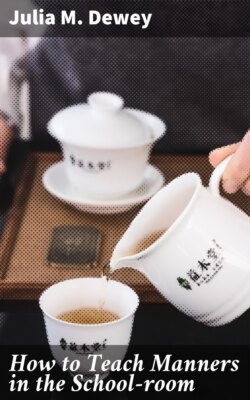Читать книгу How to Teach Manners in the School-room - Julia M. Dewey - Страница 8
На сайте Литреса книга снята с продажи.
PRACTICAL TRAINING IN MANNERS.
ОглавлениеTable of Contents
1. Ask the children daily to tell what opportunity they have improved of being kind and polite.
2. The teacher should remark on any improvement shown by the pupils, and lead pupils to talk of it. It is well to allow them to talk without restraint so as to obtain their real opinions. Tact will be needed to ward off a feeling of self-gratulation or conceit, which may otherwise be brought out when pupils tell of their own polite acts.
3. Impress pupils with the idea that good manners is one of the subjects pursued in the schools, and that it will help them in life, and that practice shows progress in this particular branch.
4. Without seeming to demand it, teachers should lead children to offer them any service that is not menial. Such attentions as disposing of wraps, umbrellas, etc., fetching them when needed, picking up things accidentally dropped, handing crayon, eraser, etc., lifting or moving things, offering a chair, helping to put things in their places at the close of school, should be rendered to teachers by pupils. If, at first, in order to make children see what offices are proper, the teacher must ask for them, it should be as one would ask an equal, and not a servant; and any service rendered should be most politely acknowledged.
5. The older children should be made to understand the propriety of assuming some responsibility over the younger. This is almost universally practiced in schools where “busy work” is done, when the older pupils help to distribute materials for such work, and to assist in its execution. They should also assist those who need aid in putting on or taking off wraps, overshoes, etc. Children should understand that girls need not necessarily assist girls, and boys boys, but that help should be offered and accepted, as is convenient.
6. Children should be encouraged to try to settle disputes or to quell disorder in any form. This does not imply a system of monitorship. As young children are pleased to do these things, it needs tact and watchfulness on the teacher’s part to keep down an overbearing or officious spirit. This may be accomplished by appointing certain pupils for a definite length of time, and by removing them from “office” when they exceed their authority. These advisers are not to be encouraged in tale-bearing. It should be considered just cause for removal, unless the tale is told in order to get the teacher’s advice as to the best mode of settling a difficulty.
7. Pupils should be trained to receive and entertain those who come to visit the schools. They should entertain as politely in a school-room as in a parlor. When visitors come, a pupil should answer the bell, politely invite the company to enter, find them comfortable seats, take their wraps if they wish to dispose of them, and offer any other attention the occasion may seem to demand. To do this properly at the time implies previous training—pupils acting as visitors. In this as in other things, officiousness on the part of pupils should be guarded against. Give opportunities to all pupils in turn to show these attentions.
8. Whenever it is possible, every direction in manners should be exemplified in the school-room. When the school-room does not furnish illustrations, directions should be made as real as possible to the youngest pupils, as, for instance, they should actually be shown how to hold the fork, how to drink from a tumbler, how to enter a room, etc.
9. The polite phrases of society should be used by the teacher to the pupil, and vice versa.
In the discipline of the school, when children have had training in good manners, the question “Is this polite?” will oftentimes prove more effectual than a severe reprimand. This has been demonstrated by actual experience, even in schools difficult of control.
